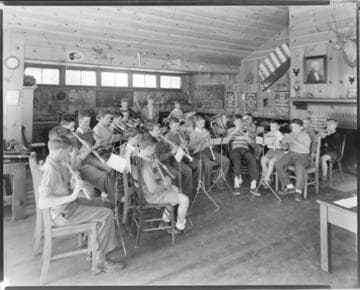Visual Materials
Claremont Cornet Band
You might also be interested in

Student orchestra, Polytechnic Elementary School, 1030 East California, Pasadena. March 24, 1941
Visual Materials
Boys play musical instruments in a classroom of Polytechnic Elementary School at 1030 East California. About two dozen boys play flutes, clarinets, drums, trombones, trumpets, and tubas.
photCL 402 (36071)

Barnum & Bailey greatest show on Earth : Carl Clair's grand military band & orchestra
Visual Materials
Image of thirty-five male military band members sitting on a stage holding musical instruments behind bandmaster Carl Clair who stands next to female musician Jessie Millar who stands on a pedestal labeled "Jessie Millar / Cornet Soloist"; with a small vignette of a head-and-shoulders portrait of Clair at top center.
priJLC_ENT_001327
Image not available
Band of 114th Pa
Visual Materials
Group portrait of 14 men from the 114th Pennsylvania Infantry Band in Zouave uniforms, posed with their musical instruments.
photCL 307 (55)

Yankee Doodle Brand
Visual Materials
Image mirroring Archibald Willard's painting "The Spirit of 1776," three military band soldiers, or Corps of Drums, marching with instruments playing Yankee Doodle, American Revolutionary War soldiers with bayonets carrying an American flag in background.
ephJLC_CIT_000841
Image not available
Claremont (1); Covina (3)
Visual Materials
This is a collection primarily of negatives and photographic prints depicting the growth of Santa Monica and Los Angeles, California, from 1860s to 1980s. Many views are cityscapes or street views, showing buildings, storefronts, homes and roads, and documenting the use of railroads, trolleys, streetcars, and automobiles. There are many card photographs by early professional photographers, and also a number of snapshots made by amateurs, some in personal photo albums. The collection's scope also includes early views of many other communities in Southern California (and a few in other states); the beginnings of aviation in Santa Monica, including the first Douglas Aircraft Company buildings; a photo album of residents in Topanga Canyon, ca. 1913; automobile racing in Los Angeles and Santa Monica, 1920s; maritime views; a photo album of U.S. troops in France during World War I; a 1949 real estate development in Apple Valley, California, and others. Besides photographs, a portion of the collection consists of scarce publications and historical ephemera, primarily related to Santa Monica and Los Angeles, including brochures, advertising cards, menus, event programs and other materials. Highlights of the Santa Monica images are aerial views of the buildings along the coast and pier (1920s); several views of the Arcadia Hotel (1880s); the Long Wharf and adjoining railroad and train depot; the first bath houses on the beach; the beach club culture of the 1920s and 1930s; the amusement piers of Santa Monica, Ocean Park and Venice; and the beginnings of the Douglas Aircraft Company. There is a large set of promotional photographs made late 1920s-1930s by Powell Press Service depicting people enjoying Santa Monica's beaches, clubs and outdoor recreation. An important subset within the collection is 407 negatives made ca. 1890 - 1908 by Los Angeles historian and amateur photographer George W. Hazard (1842-1914). Hazard travelled around Los Angeles and vicinity photographing the adobes, houses, streets and storefronts that told the early history of the city. Many of Hazard's negatives have handwritten identifications, naming streets, former homeowners, ranchos, and other historical details. There are a large number of cabinet cards and other card-mounted prints and stereographs. There are 1,264 stereograph prints, highlighted by the works of photographic pioneers William M. Godfrey, Francis Parker, Hayward & Muzzall, and Carleton Watkins. Other formats represented are: glass and film negatives; panoramic prints; 7 photograph albums, photographic postcards, 20th-century color prints and transparencies; and a small number of tintypes, cyanotypes and a set of chromolithographs.
photCL 555

Eureka Elks Band
Visual Materials
Group portrait of the marching band of the Elks lodge of Eureka, California, standing in uniform with their musical instruments around a drum labeled "Eureka 652 B.P.O.E., on the Redwood Highway, California."
photCL_555_05_167